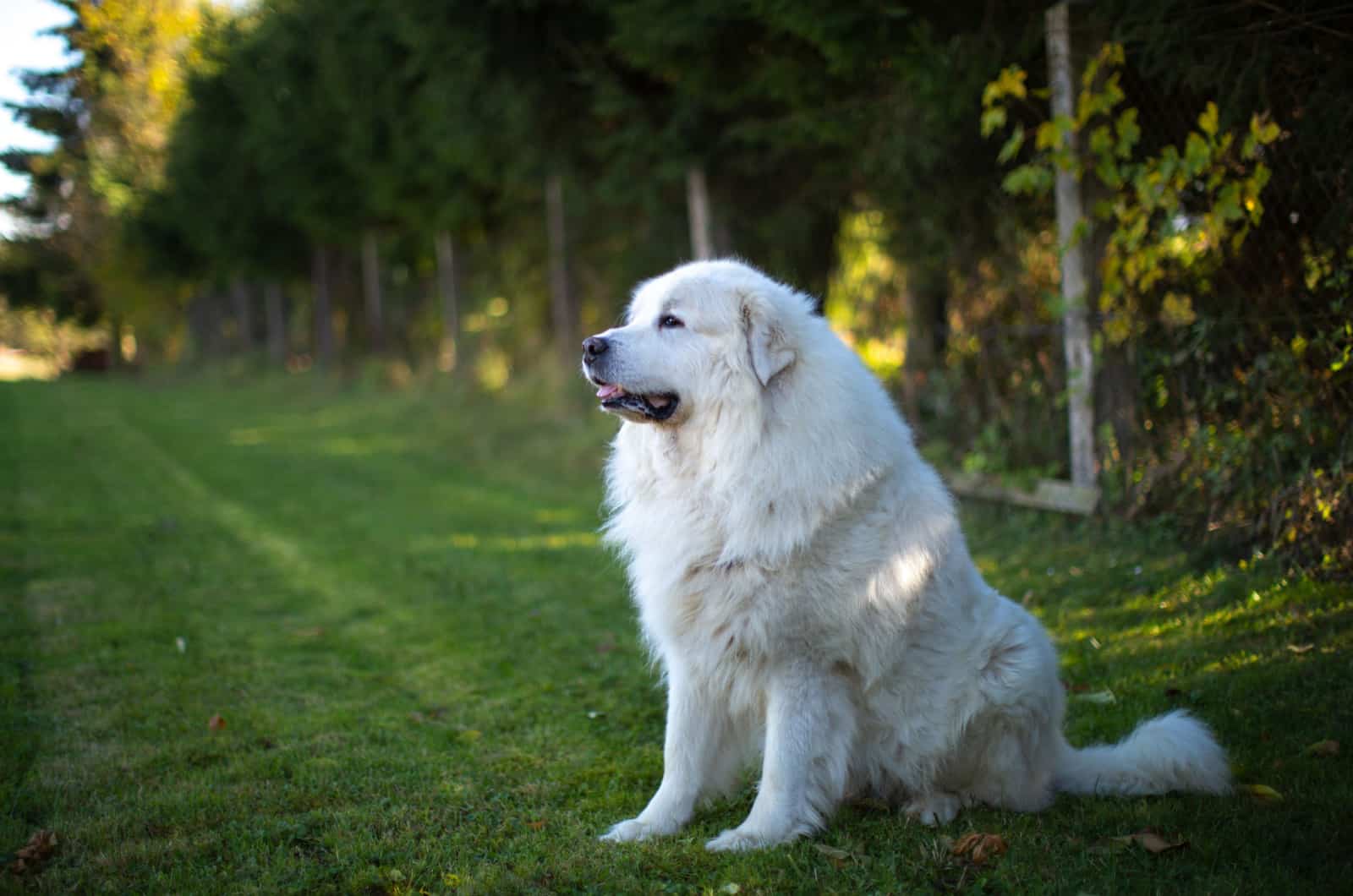The Great Pyrenees is a wonderful and large dog known to not eat an awful lot. However, he still needs to follow some diet which is why we use a Great Pyrenees feeding chart.
A Great Pyrenees feeding chart helps dog owners better understand the needs of their pet through each and every life stage they go through and is a good foundation to help construct a proper feeding guide for your own canine companion.
Keep in mind that the data presented in these feeding charts is often about the average member of the dog breed and may not accurately coincide with your own dog’s needs.
Every dog is unique in their own way after all and your Great Pyrenees is no exception.
In order to get his dietary plan in order, you’ll need to go through a little bit of trial and error and a handful of visits to the vet or a pet nutritionist.
But to prepare you on this journey of discovering what and how does this majestic fluffball of a working dog eat, I’ll run you through some of the fundamentals to make your role in this a lot easier.
So, read on to find out what this feeding chart looks like as well as discover some of the most commonly asked questions regarding a Great Pyrenees’ health and feeding habits as well as their answers.
The Great Pyrenees Feeding Chart: What It Looks Like
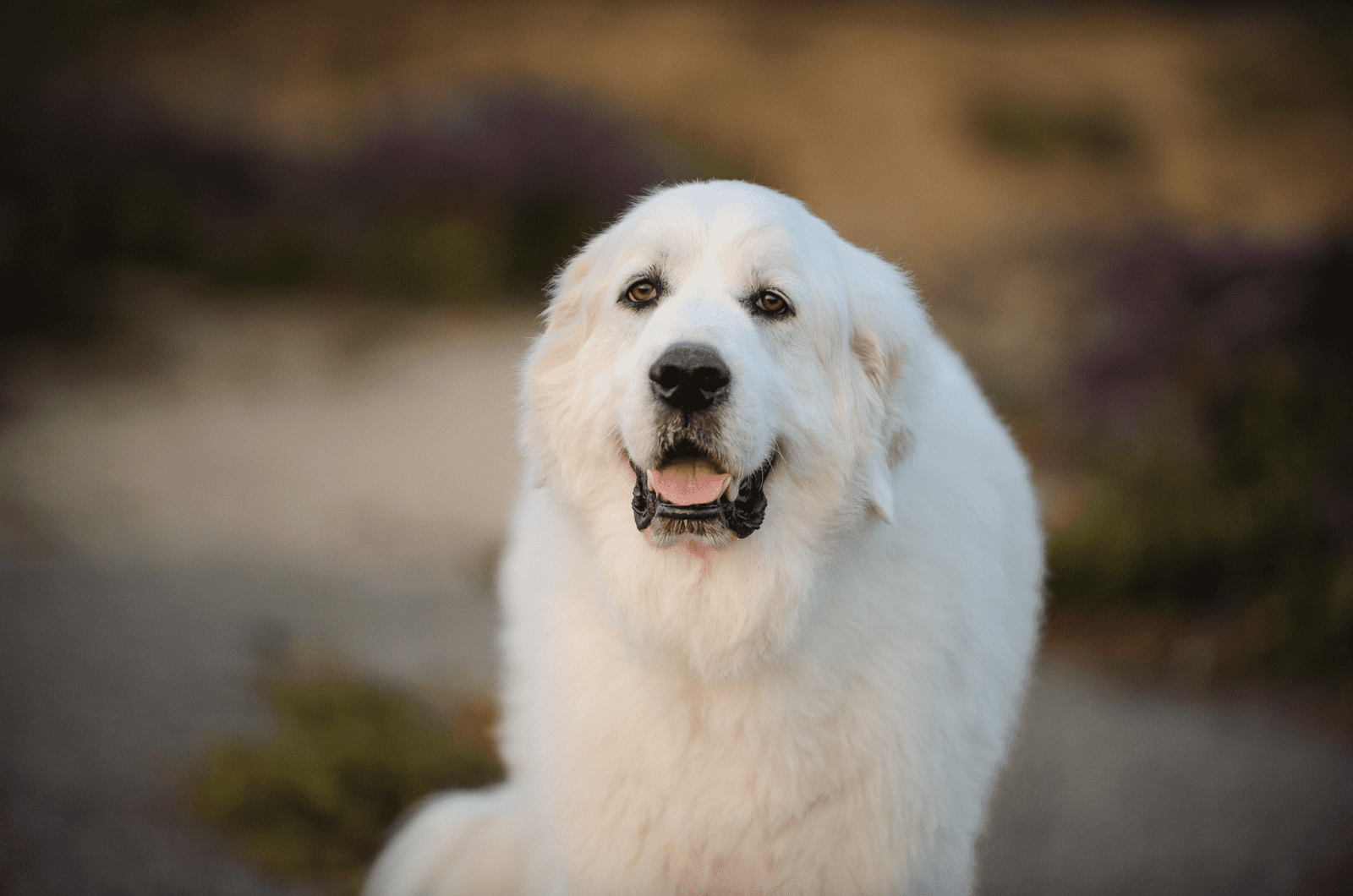
[table id=554 /]
The feeding chart for larger breeds often has these sizable differences in daily food amounts due to the larger weight range that they can occupy, especially these durable mountain dogs.
And if this is the average, you can only imagine some of the outliers.
The main reason for such a sizable amount of food for a Pyr is to help keep his energy levels up throughout the day.
Large dog breeds exert more of it so it’s only natural that they’d need more calories over some of the smaller breeds.
Also, these measures show the amount of high quality dry dog food needed. If you want to add wet dog food into the mix, you’ll have to measure the difference out.
Of course, you can just fine tune it as you go along, especially since your precious pooch may not have the same eating habits as most Pyrs do.
Speaking of which, his diet will keep changing as he goes through his various life stages.
0-12 Months Of Age
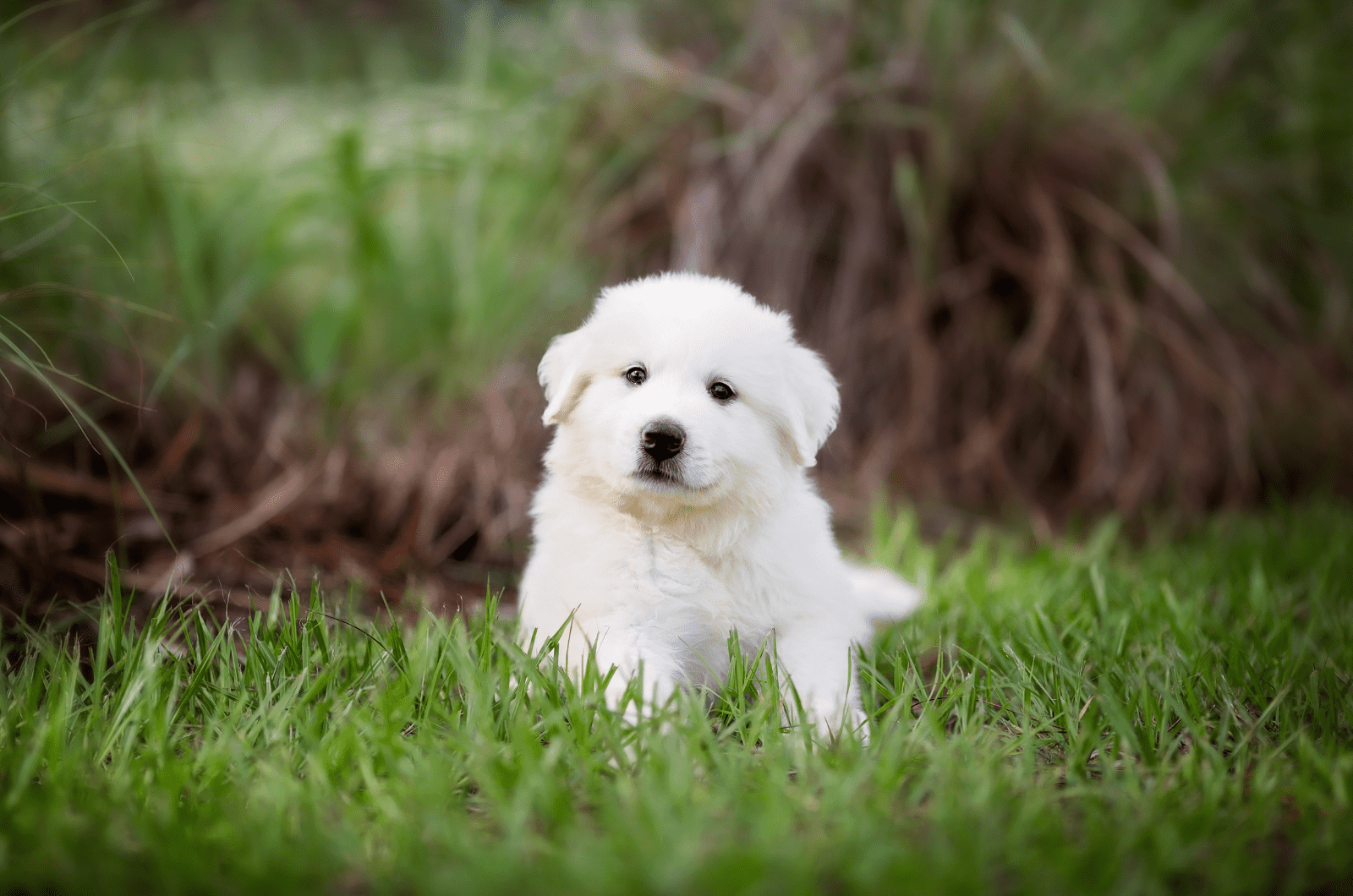
The, so called, puppy stage, a period of time where your dog will mostly be relying on his mom’s milk and calorie dense puppy food to help develop himself properly.
While most results about daily calorie intake will vary greatly in this 12 month period, expect places where you may even need to feed your doggo up to around 1700 calories a day when he starts nearing his first year of life
1-7 Years Of Age
At the start of the adult stage for your dear doggo, you should be swapping over to adult dog food to help keep a healthy weight on your canine companion.
The difference between adult and puppy options is that the adult has way less calories while still providing the essential nutrients vitamins and minerals your dog wants to meet his daily nutritional needs.
The calorie count can vary here just as much, ranging anywhere from 2100 all the way up to around 3400 calories depending on how active your doggo will be.
The latter number is usually reserved for working Pyrs rather than ones who get a few walks a day, though it’s best to consult your pet’s veterinarian or a certified pet nutritionist on the matter so you can get a better estimate for your darling doggo.
7+ Years Of Age
This is where your adult Pyr transitions into a senior dog. His metabolism will slow down and he’ll become much less active, meaning he’ll need fewer calories.
It’s best that you swap to food aimed at older dogs that’s easier to digest but doesn’t have quite as many calories.
And, while the chart does suggest less daily meals, if your dog is in danger of bloat, you may want to try dividing his meals up into a few more with less content, though this method hasn’t been proven to always work.
In order to get a closer estimate to what your dog’s required calorie count is, consult with your vet and perform check-ups often as Pyrs are large dog breeds who are more prone to different health issues.
What Do Great Pyrenees Eat Through The Various Life Stages?
As is shown above, Great Pyrenees, much like any dog, don’t maintain the same diet throughout their lives as different life stages require different food options as well as different daily calorie needs.
Things often shift due to other reasons be it age, health problems, activity level or similar. But, regarding the standard stuff, here it is in a little bit more detail.
0-2 Weeks Of Age
As with most dogs, the first 2 weeks are relatively the same, your Pyr will be dependent on his mom to get his daily mother’s milk amounts in so you shouldn’t worry too much about following a strict feeding guide just yet.
At least not for the pupper, the mom should, however, have access to calorie-dense food options that always fill her bowl so she can keep her own feeding schedule in check when it comes to her pups.
4 Weeks Of Age
Once Pyrs hit this threshold, a few of them should start getting interested in the weaning process, wanting to try something else other than their mom’s milk.
While this should still be their primary source of nutrition, you can start introducing some solid puppy food to them, albeit mixed in with 3 parts water, 1 part food.
This gives the concoction a similar consistency to that of their mother’s milk which will be more agreeable to their otherwise sensitive digestive system.
Gradually, you’ll want to increase the amount of dog food in the concoction to let them slowly adjust to the new standard until you no longer need to use water outside of softening the kibble up a little if needed.
Though, not all of them will be interested in the shift just yet, and that’s fine, as long as it’s done by week 8, there should be no issue.
6 Weeks Of Age
At this stage, the Great Pyrenees Puppy should be more receptive to the puppy food idea more so than mother’s milk.
It’s at this point where you should slowly start coaxing the others who still haven’t gotten around to it so they could be fully independent by week 8.
It’s not just for the pup’s sake, it’s also for the mom as she won’t be as eager to nurse them as she would’ve been for the weeks prior. She too wants to walk around and be active again instead of being a food dispenser.
She’ll help out in this weaning process by not being around as much for the kids so they’ll have to resort to the alternative which will soon become their norm.
That said, you shouldn’t free feed them on this concoction as these giant breed puppies likely don’t know when to stop yet.
Instead, to very small meals up to 5, maybe 6 times per day depending on their weight and they should be good.
Though, to get an exact measure, I advise consulting your vet on the matter.
8 Weeks Of Age
If you’re a breeder, the 8 week mark is when the puppies should be ready to get rehomed so the new owners have the best chance of taking him in and the dog to take to them as well.
It’s also at this stage that your dog’s food needs will start to increase at a faster pace, though it’s still best to start it off slow.
While the risk of a few pounds extra isn’t that big of a worry for a giant breed like the Great Pyrenees as it would for a small dog breed, it’s still advised to go for the minimum which is 1 or 2 cups a day over 4 meals.
Use that as a foundation and then increase if needed. Don’t forget to ask about anything that may be a concern or that may need enlightenment from your vet or pet nutritionist.
Aside from that, if you’re a dog owner, you may find your little guy to be a bit scared of his new surroundings, so try to be as accommodating as you can to get him used to you and his new place easier.
This way, he’s a lot less likely to skip meals.
10 Weeks Of Age
By week 10, your Pyr pup should’ve adjusted to his new household now and be in much better spirits.
It’s also the period where he’ll hit a growth spurt and will need more food added to his daily plate.
The usual amount for this age period is about 2 to 3 cups a day, spaced out over 3-4 meals, but, as usual, it varies from dog to dog.
Keep fine tuning how much food you give him until you settle on the right amount.
12 Weeks Of Age
At this point, it’s mostly business as usual, your pup should be growing at a healthy rate. Don’t be surprised if he practically grows overnight.
Just make sure to keep bringing him his meals and increasing the daily calorie count if necessary.
Don’t go too far though as you don’t want to overfeed him and cause him to teeter on obesity.
While a few extra pounds won’t hurt, they’re much harder to melt on a large dog breed than they are on a small one.
Getting To The First Year
Up until adulthood, it’ll mostly be standard procedure where your dog will have his growth spurts every now and then, growing into a large and fluffy adult over time while you monitor his calorie intake.
It doesn’t have to be precise, it’s certainly not rocket science and every piece of kibble isn’t the same, so you’re allowed to eyeball it.
But, as always, don’t go too overboard.
The only thing of note is that around the 9th to 11th month, you should start transitioning your doggo from puppy food to adult food.
Use the same method as you’ve done with the shift from mother’s milk to puppy food, though with no water this time around.
3 parts puppy dog food and 1 part adult dog food, then gradually increasing the latter until the former becomes a thing of the past.
Year 1 To Year 7
This is the stage where your dog is considered an adult, and, depending on his size, you’ll need to up that daily calorie count by a lot.
Some of the largest Pyrenees may need up to 7 cups of high quality dry dog food a day, especially the more active ones, herding dogs who work in the mountains a ton.
Aside from that, it’s business as usual, there aren’t really going to be many changes unless you want to get him used to a new brand of kibble, in which case use the tried and true method of slowly helping him adapt.
Year 7 And Onward
Closing in on the end of his adulthood, your Great Pyrenees is likely to start becoming less active and slowing down overall.
It’s nothing unusual and is mostly tied to getting old. He’s now considered a senior dog and things should be adjusted accordingly.
If he’s having issues with his digestion with the kibble you’ve been feeding him while he was an adult, you may need to swap to dog food aimed at senior dogs.
His calorie intake is also going to lower given his slowing metabolism so start lowering his daily food intake to anywhere from 4 to 6 cups, gradually decreasing as he ages further.
How Many Calories Does A Great Pyrenees Need Daily?
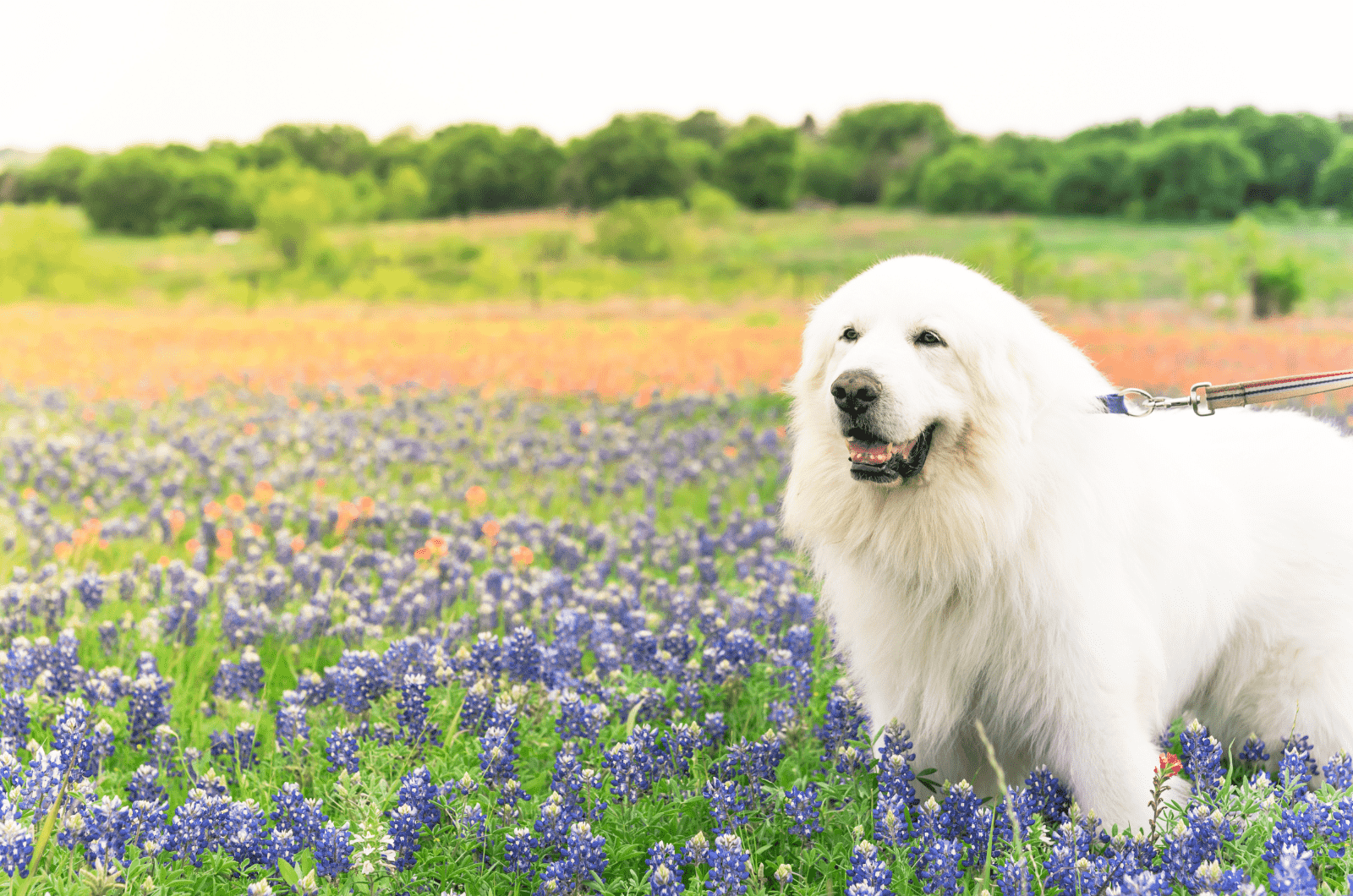
Calculating for a large breed is a bit different than it is for a medium one.
They use a formula revolving around RER (resting energy requirement) which is slightly modified to accommodate small and large breeds alike.
It looks like this:
70 x body weight in kilograms to the ¾ power = RER for small/large patients
It helps you figure out the daily average calorie count for a dog of that specific weight, however, a lot of different things factor into this too that you need to be aware of.
The Dog’s Age
One of the dog’s main reasons for needing to eat less or more is his age.
When he’s young, he’s still a growing boy and needs all of the calorie-dense nutritious goodness he can afford.
It is the energy he’ll have to burn through to feed all of his growth spurts after all.
As he grows older, the daily needed calorie count will peak somewhere in his adulthood, but he won’t be eating the same food and will instead swap to a more nutrient-rich diet.
This way he gets to eat more while also satisfying his daily nutritional needs. Plus, he’ll consume it in less meals to better accommodate his weight as sticking to more meals with less would just end up leaving him hungry.
As the descent into seniority starts, the amount of daily calories lowers slowly but surely due to their slowing metabolism, much like the case would be with any of us if we hit our late 40s .
Some dogs get to stick with their adult food, but it’s usually best to adapt to a senior dog’s diet of nutrient rich food but with lower calories. One that’s easier to digest and will meet his daily nutrient and calorie counts with a lot less food.
The Level Of Activity
Another key metric is the dog’s level of activity. Obviously the more a dog walks or runs around, plays with his dog owner or his peers, the more calories he’ll need to keep that lifestyle up.
For the Great Pyrenees, there’s also the possibility that he’s being used as a herding dog or has to climb rough, mountainous terrain, which also adds to that needed calorie count.
And given how he’s considered a large, or even a giant dog breed, these things make a whole lot of difference, up to several hundred calories of difference in fact as compared to some of the smaller dogs out there.
Health Issues
Various issues that affect your dog’s digestive system can shift the daily calorie intake dramatically too, as can any potential injuries.
Whether it’s a loss of appetite or an increased one, or a depressive stint that may cause a loss of appetite, you’ll need to adapt to the situation.
Pregnancies
If you’re a proud owner of a female Pyr, then you’ll also have to worry about pregnancies and birth in general.
A pregnant dog will need more nutrition and calories than before so she can provide for her pups and so she can keep her own strength up.
The same goes for when she gives birth and has to feed them milk, it has to come from somewhere and those calories that you feed her will normally be transformed into it.
This is why pregnant momma’s are commonly free fed to let them pace themselves out.
Spaying Or Neutering Your Dog
Another common reason for your dog’s shift in eating patterns is when you spay or neuter your dog.
The procedure ends up cutting hormone production by a solid amount to keep your dog from being too aggressive meaning the body won’t burn as many calories to produce them so you’ll need to lower them.
Fine tuning will be needed as there’s no exact number you can just subtract since every dog is different.
Another thing you may encounter related to this procedure, that thankfully only lasts a short time in most situations, is post-procedural depression.
This usually leads to a loss of appetite in the affected dog, but should clear itself up anywhere from a day to a week.
If it doesn’t, or if your dog starts having some other adverse side effects from the procedure itself, call your vet immediately and alert him of the problem so you can schedule a check-up and see what the problem is.
What Makes For The Best Dog Food?
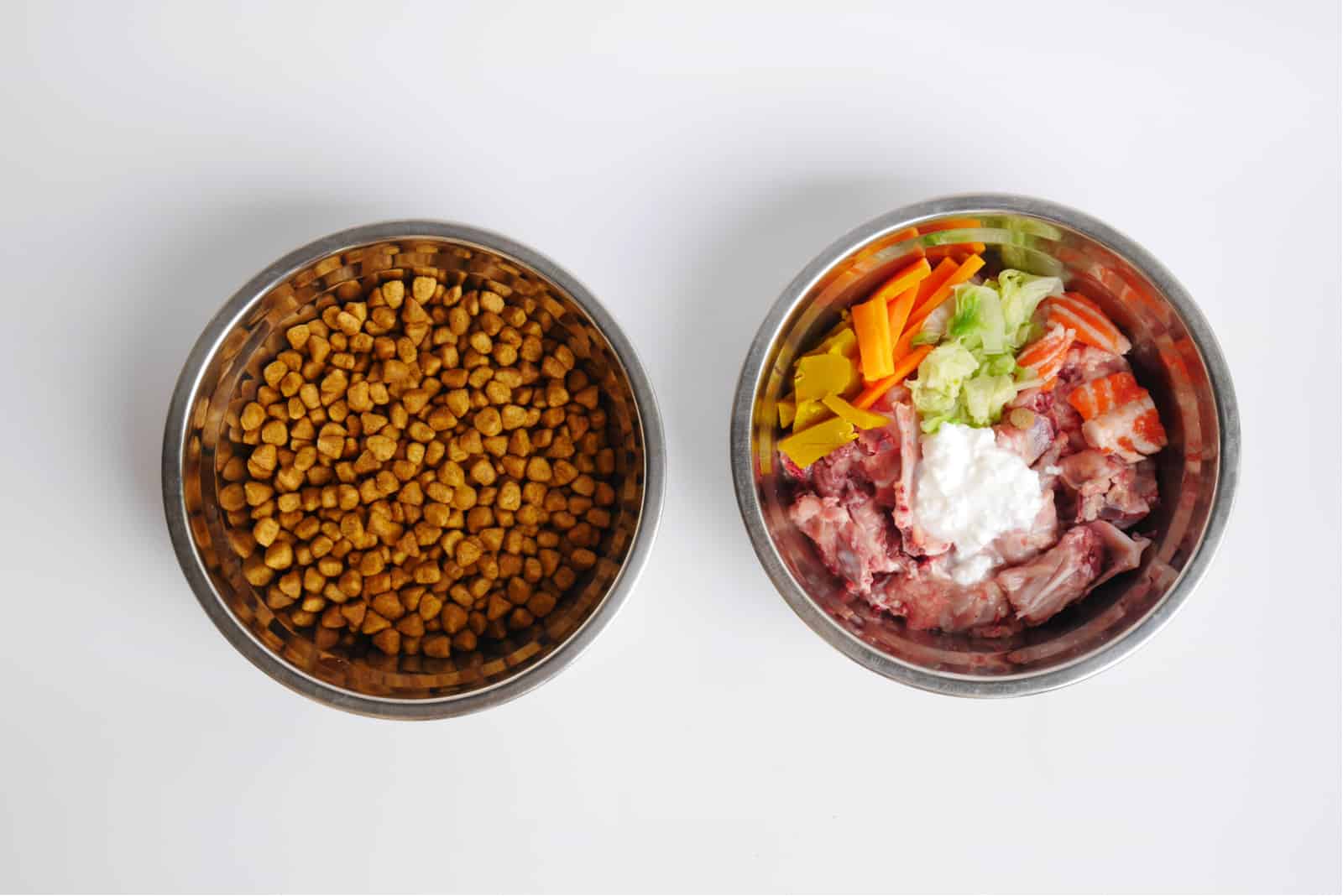
While the title of ‘Best dog food’ is going to depend on your own canine companion’s specific tastes, there are a few factors that determine a food’s quality regardless of the fact.
Good Meat Protein
The basis for any solid food is quality meat as the main protein.
For dogs, getting beef or chicken is the most preferable while turkey, fish or similar serve as decent alternatives. You’ll want his kibble to have around 26% protein content.
Needs Some Fiber
Fiber helps slow digestion and keeps dogs sated for longer periods of time. It also allows the body enough time to absorb all the nutrients from the food and let nothing go to waste.
One of the most common fiber supplements in dog food is brown rice, so look for it in the ingredient list.
Other good options are sweet potatoes or even barley which do the job just as well.
Pair It Up With Some Fats
Big dogs need some healthy fats to burn in their food too. For the Great Pyrenees, it’s recommended to have at least 8% of the food content to be healthy fats.
Nutrients And Vitamins Are Essential
As always, you’ll want to have all of the essential vitamins and nutrients in a dog’s diet. Some of the most relevant ones for any large breed dog would be Glucosamine and Chondroitin.
These help improve bone and joint health which is extremely relevant in large dog breeds as these tend to be their weakest points and wear out real quick.
Calcium and phosphorus are essential too, especially in the puppy stages where they serve as the main building blocks of his bone and joint structure.
Omega 3 fatty acids are another relevant nutrient which aids the whole body, but primarily helps keep skin hydrated and keeps your Pyr’s fur fluffy and strong.
Probiotics are always relevant to keep your dog’s gut health at optimal levels and to keep his immune system healthy.
Limit Carbs
A small amount of carbohydrates is okay, but most dog food tends to have a lot naturally. Try not to go overboard as a dog’s stomach wasn’t really built on processing through carbs too quickly.
Feeding him too much on the stuff could lead to various health issues and can make him feel sluggish throughout the day.
Avoid Meat By Products And Fillers
If there’s one thing your doggo doesn’t need, it’s any fillers or meat by-products like chicken, beef or turkey meal.
All of these are used to inflate calories and cut costs by providing you with a lower quality product. Avoid if you can and settle for a higher quality option at a similar price.
Artificial Ingredients Are A No-no As Well
The one thing more damaging to a dog’s health than excess calories are various hazardous chemicals, artificial colors, flavors or preservatives.
They may make the food cheaper, but they also make it more likely for your Pyr to suffer from some major health issues.
Grain-free For Sensitive Stomachs
A good portion of dogs tend to be allergic to specific grains like corn, wheat and soy, or gluten in general for that matter.
If that’s the case for your dear doggy, then it’s best to find a product that doesn’t contain any of the aforementioned ingredients.
Thankfully, there’s plenty of choice out there, so you won’t be missing out on some specific part of a product.
What Is The Best Dog Food For A Large Breed Puppy?
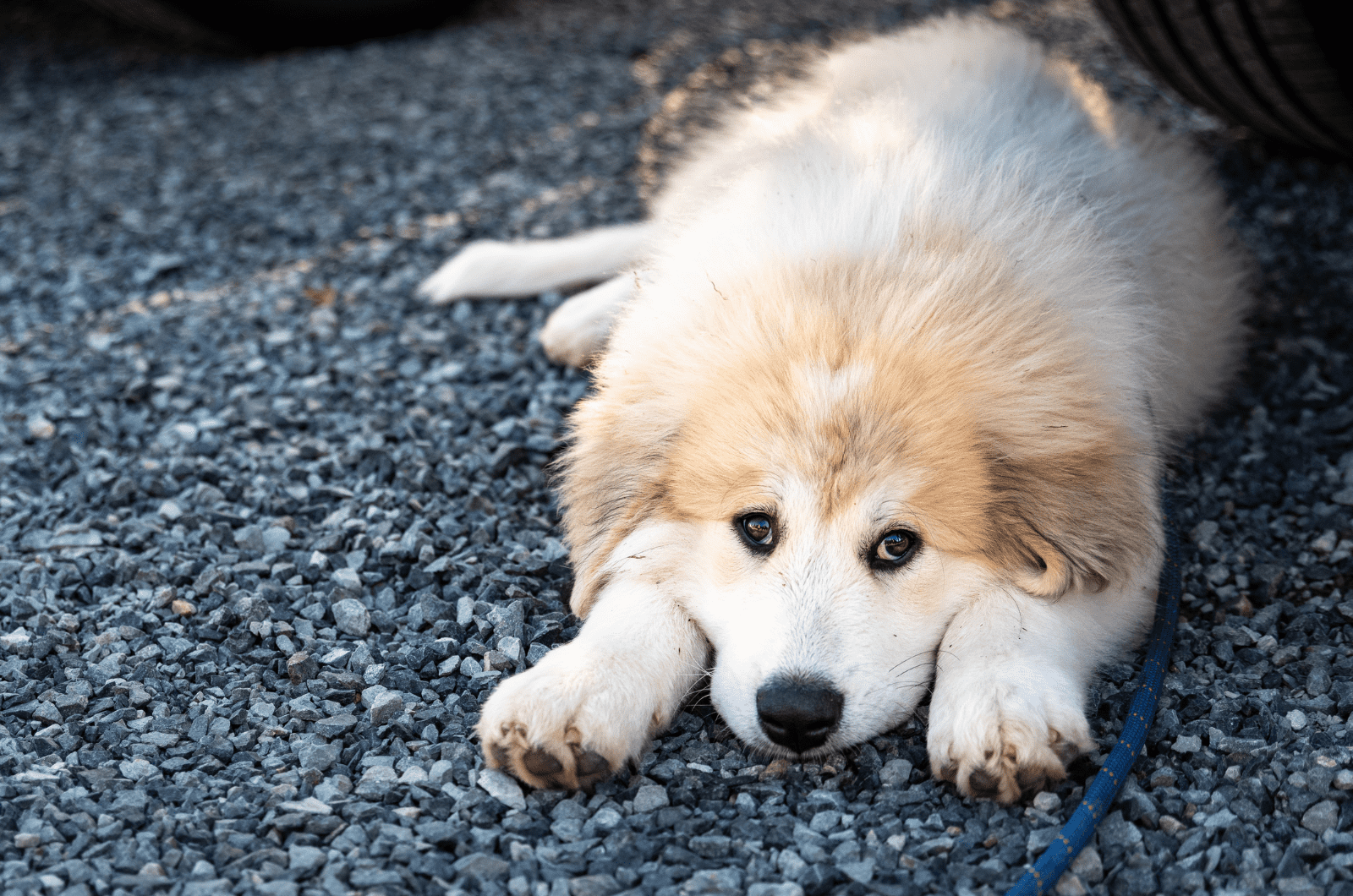
Usually, you’ll want something soft and calorie dense that still packs enough vitamins and nutrients to get your dog throughout the day.
Something that’s easy on the gut as theirs hasn’t fully adapted to adult kibble yet.
The best puppy food can be found at either Purina or Blue Buffalo, among various other popular dog food brands and they can be found on both Chewy and Amazon.
Is Wet Food Better Than Dry Dog Food?
Dry food is generally considered better as its denser texture helps with cleaning teeth and is usually less calorie intensive.
Dry dog food also helps dogs pace themselves whereas the wet stuff, in my experience, just slides on down within seconds.
Wet dog food also tends to stain teeth which is counter productive to the health of one of your dog’s greatest tools.
However, wet food often has better taste so it shouldn’t be overlooked, but it shouldn’t be the main dietary option.
You can give it to him every now and then or simply mix it in with the dry stuff to make it taste better.
Either way, the wet food is also usually more expensive per meal, so it’s not a great budget option either.
What About A Raw Food Diet?
Raw food can be another great topper for dry food to make it more palatable to your dogs if he’s not enjoying it solo.
The benefits of raw food are lower carbs and a better taste at a fraction of the cost of wet dog food.
Though finding the raw food that your dog may like or even one that’s simply safe for him can be a chore all on its own.
Usually, the safest would be some form of vegetable, fruit, yogurt, muscle or organ meat or bones.
However, it’s best not to buy too much as you never know if your dog’s going to like it or not, or if it even fits with his gut.
Try it out in small amounts, then purchase more if he seems to enjoy it. Do account for it in his daily calorie count though.
What Happens If My Pyr Doesn’t Want To Eat?
There are multiple potential reasons behind this.
The first one could simply be that he’s had his fill and doesn’t need to eat any more right now, pretty common as Great Pyrenees dogs know how to control themselves and usually won’t overeat.
Another cause could be an issue with his stomach or a mild case of depression.
If the problem doesn’t go away, however, you should contact your vet to ask for advice or schedule a check-up so you can get to the bottom of this before it causes any larger problems.
How Active Does A Pyr Need To Be?
Despite the varying levels of activity, a Pyr doesn’t necessarily need to be all too active like other giant breeds like the Great Dane or the Newfoundland.
A puppy needs about 20 to 40 minutes of activity while an adult will only want about two hours of activity a day to have him set and should prevent excess weight gain from a standard diet..
Make sure they’re surrounded by others at all times too so they don’t get bored or depressed. The Great Pyrenees is a family dog after all and doesn’t like being cooped up in the kennel all day.
In Conclusion
The Great Pyrenees feeding chart gives a rough estimate on what you need to do to keep him fit and healthy.
To construct a proper diet for your Pyr, it’s best to consult both the feeding and the growth charts to find out what the average amount of calories would be for his weight and level of activity, then refining the amount from there.
Of course, advice from a vet or a pet nutritionist shouldn’t be neglected as it’ll help you reach the correct amounts of food a lot faster.
Whatever the case may be, I’m sure that you’ll be able to find the right balance of food to give your Pyr a long and happy life.
RELATED LINKS:
• Great Pyrenees Dew Claws: Should You Keep Them Or Not?
• 13 Reliable Great Pyrenees Breeders From Across The States
• Great Pyrenees Training Tips You Didn’t Know You Needed
• How Much Does A Great Pyrenees Cost: Price For A Big Dog
• Great Pyrenees Colors: Truth About White Mountain Dog
• Great Pyrenees Shedding: Is There Anything You Can Do About It?
